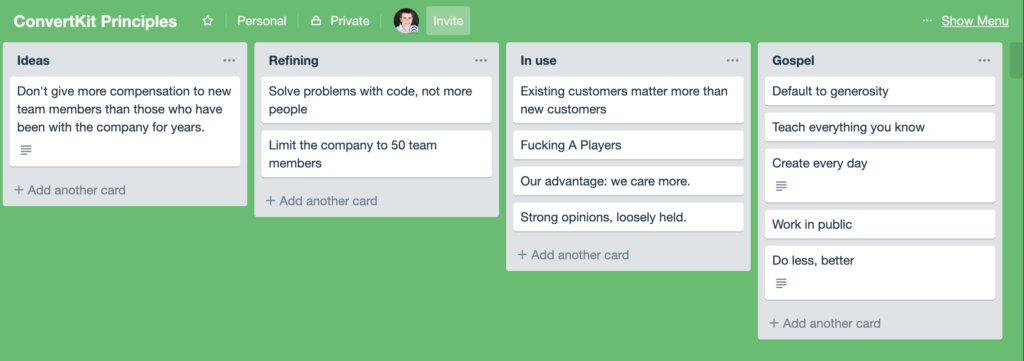Making every decision from scratch is messy and time consuming. Especially when you are building a team and pushing them to make great decisions that align with your values.
That’s where principles come in. Simple ideas that clearly communicate a specific course of action.
Each decision becomes more clear when you can share the principles that led you to that conclusion.
Example Principle: Default to generosity
If a customer asks for a refund, do you give it to them? Usually in software there’s a standard 30 day refund policy. But what happens in a special case where a customer is asking for more of a refund? It could be because of product issues, something going on in their life, or they simply didn’t get a chance to use the product over the last few months.
You could define what your support team should do in all of these scenarios—we started to at ConvertKit—but ultimately we gave each customer support team member one principle:
Default to generosity.
Use your judgement—after all there are plenty of people who will be thrilled to abuse your generosity—but default to generosity.
A system for creating principles
We have quite a few principles that have slowly evolved over time at ConvertKit. But we don’t have a defined system for creating and refining more. This post is a first attempt at turning a scattered process into a reliable system to create new principles.
Each principle starts as a rough idea, then over time is refined and restated, before eventually becoming established as a core part of our decision making process.
Trello is perfect for visualizing moving these through the steps of our system.

step one: write a first draft
Write a sentence to define your principle. Then in the card list alternative ways to phrase the same principle. What is the context for considering this as a principle? Do you have any example of putting it into practice? Any stories?
Then copy in these questions as headings and answer them in the body of the card:
- What does this principle mean?
- When would this be put into use?
- What types of decisions should I apply this to?
- How else could you phrase the principle?
This all goes in a single card in the “Ideas” stage of your board.
STep two: Start a discussion
Now pull in your team and ask them to comment and discuss on that card. Often your team will have better ideas for a new phrase that better represents the core principle.
Ask them to suggest more example decisions to see how this principle would apply. Ask them where they think this principle could get us into trouble. In other words, what are the unintended consequences of adopting this principle?
Step 3: Try it on
After a week or two of solid discussion, move the principle to the refining stage and start using it. Each time you use the principle in discussion or a decision, make a note back on the card in Trello.
- How do people react when you use it in conversation?
- Does it resonate with teammates?
- Does the principle bring insight or are you simply stating the obvious?
Once it passes these initial steps push it further by arguing the opposite side.
Step 4: Argue The opposite
The next time you are faced with a decision, reach a conclusion based on your principles. But then take a step back.
What if you had to argue the opposite side? Let’s pretend you have the opposite opinion. What principles could you establish to reach that new conclusion?
Relying on principles can make a decision feel more black and white than it is. And if you’re not careful with how you use them in a discussion, you can shut down opposing arguments before they have time to truly form.
Step 5: Use it with the entire team
When it feels like the principle fits and has passed basic tests it’s time to do a full write up and share it with the team! At ConvertKit that would mean a Basecamp post explaining all the details and summarizing the examples and discussion from our Trello card.
Nothing would be a surprise, since we were open throughout the entire discussion, but inevitably some people will have been more involved than others.
Finally, after it’s been in use for a year or so, we’d immortalize it on our mission page and in our company handbook to fully adopt it as company gospel.
A few of our principles
For the last few years at ConvertKit we’ve been slowly writing and refining our principles. Here are a few that often come up in day to day planning at ConvertKit:
- Existing customers matter more than new customers – If we don’t take care of our existing customers, we don’t deserve new customers. When you become part of the family, you can trust that we’re in it with you for the long haul.
- Create every day – Our best days are the ones when we create. Every person on the team is a craftsperson and can roll up their sleeves to help build a better product and company. We believe consistent progress every day leads to incredible results.
- Do less, better – We focus on what matters most from the product to our marketing to the customers we seek out. We know that when we do a smaller number of things with excellence, everyone wins.
It’s time to write your own
You can follow this process individually or as a company. Often what starts as a personal principle for one team member will be adopted by more of the company.
Whatever process you follow, get the principles out of your head and down onto paper. Then circulate them with your team, friends, or peers to refine and sharpen them into something worth standing behind.
Do you have principles you use in decision making? Share them in the comments.



This is great, Nathan – thanks for sharing.
But I’m dying to know… what is “Fucking A Players”? :)
Would also like to know
This post talks about A Players. https://fs.blog/2019/04/a-players/
Great post! Like the idea of using Trello for that!
„There is always enough time.“ – That’s one I found out lately and defined as one of mine. When I think I need to rush things that’s the opposite principle I try to life by.
I also like „Everything can be fixed.“ which goes more into the direction of building relationships, letting go of things of the past.